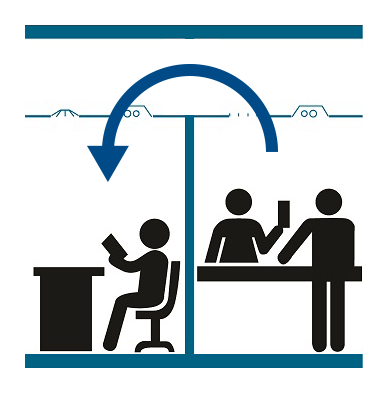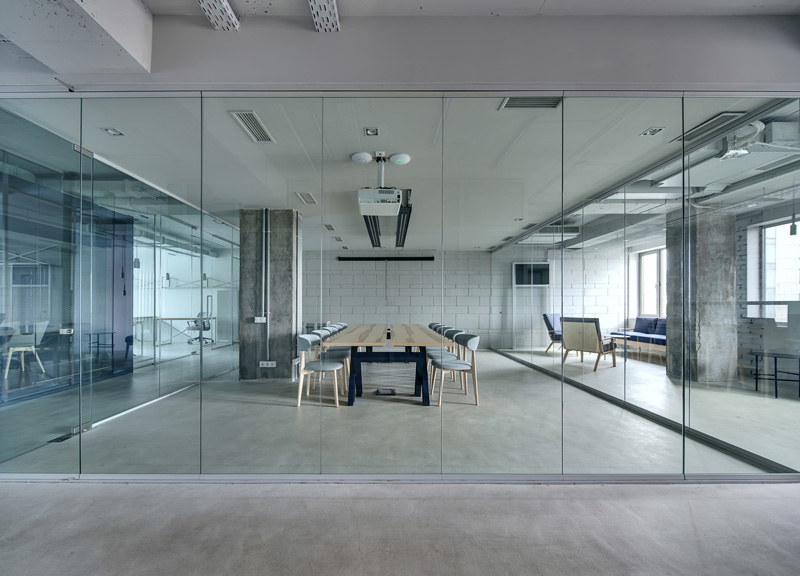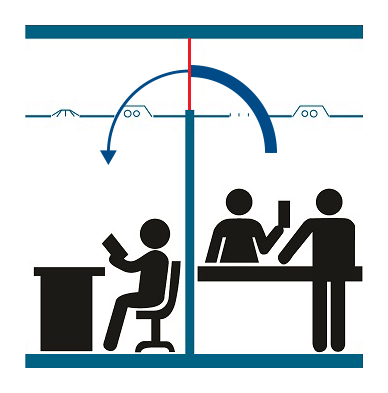By François Gariépy
How Good Are Movable Walls at Maintaining Privacy?
With the ever-growing rise in popularity of open floor plans, it makes perfect sense to incorporate movable walls into the design of office spaces. As the name suggests, movable wall panels, or demountable walls, are walls that can be relocated, reinstalled and unmounted to be moved to a different location.
As one may expect, traditional drywall construction can be a time consuming, expensive and messy enterprise. Conversely, movable walls give businesses the opportunity to create individualized workspaces, offices, and collaboration rooms in a matter of hours, without creating any environmental waste. What’s more, movable walls can deliver the added benefit of increased visual and auditory privacy, especially in open-plan offices where audible conversations inevitably drift across the busy workplace. Indeed, it’s important for office designers to understand the role privacy and personal space plays in employee productivity. Movable walls are yet another architectural innovation that designers can leverage to deliver the kind of workspace atmosphere that optimizes focus and promotes productivity while ensuring employee wellness. But just how effective are they in terms of providing true speech privacy?
Over the years, our experts have measured the acoustical performance of many different brands and configurations of movable walls in real-world installations. This article consolidates key takeaways and helps you establish realistic acoustic performance expectations when using movable walls into your interior design projects with the goal of providing occupants with better auditory privacy.
Understanding Key Definitions
First off, understanding the following definitions is key to assessing the true acoustic performance of any given interior partition, including movable walls, drywalls, doors, and ceiling tiles.
Transmission Loss
The transmission loss is the attenuation of sound traveling through a partition. If the sound level is 80 decibels on the source side and 30 decibels on the receiving side of a partition, then the global transmission loss is 50 decibels.
STC – Sound Transmission Class
The STC rating is the standard index used to measure sound transmission loss through partition walls and quantifies the loss with a simple number. Simply put, STC tells you how well a building partition attenuates airborne sound. The STC rating expresses the amount of dB lost through a partition, which means that, on average, a STC-35 partition attenuates sound by approximately 35 dB. The STC rating of a partition is generally measured in a lab. For this reason, it’s a useful but strictly theoretical figure that doesn’t take into account key factors such as speech intelligibility and background noise levels. Moreover, STC doesn’t take into consideration the fact that real-life construction involves structural sound leakages, a lot of which created by wall sockets and electrical outlets, resulting in relatively bad acoustic performance in otherwize strong structures.
ASTC – Apparent Sound Transmission Class
The ASTC rating is always measured on site, so it includes acoustic leaks or deficiencies in the partition. The ASTC rating of any given wall is therefore always lower than its theoretical STC value. It’s common to have an ASTC rating that’s 5 points lower than the STC rating but the difference can be greater in many cases.
CAC – Ceiling Attenuation Class
The CAC rating is the sound transmission loss through the plenum space. In theory, ceiling tiles with a CAC index of 35 points attenuate the sound traveling through the plenum space by approximately 35 dB.
SII – Speech Intelligibility Index
Speech intelligibility index (SII) is a measure, between 0 and 1 (or 0% to 100%), that represents the ability to hear speech under a variety of adverse listening conditions, such as noise masking, filtering, and reverberation. The SII index indicates the percentage of syllables that can be clearly understood in conversations. A lower SII number means less intelligible conversations, while a higher SII number means more intelligible conversations. You can read more about speech intelligibility index here.
Movable Walls in Open Plenum Designs
More often than not, in open plenum designs, the main path of sound transmission is through the plenum space.

The acoustic performance of movable walls in open plenum designs is mostly defined and limited by the transmission loss of the ceiling tiles. The CAC rating of the ceiling tiles determines the overall performance. Ceiling tiles have CAC ratings in a range between 20 and 40 points (approximately 20 to 40 dB of transmission loss). Now, “typical” ceiling tiles have CAC ratings around 30, so even the best of walls will only allow you to achieve an ASTC rating of roughly 30.

Real Measurements:
We have measured the acoustic performance of dozens of movable walls in open plenum designs. ASTC ratings generally were around 30 points. In the worst-case scenarios, the performance was as low as ASTC-22. In the best-case scenarios, around ASTC-35.
Movable Walls in Closed Plenum Designs
If the plenum space is closed, with a deck-to-deck wall or with a plenum barrier, then the acoustic performance can definitely be improved compared to open plenum designs.

Using deck-to-deck gypsum walls, it’s possible to achieve as much as ASTC-55 between offices which can be considered an excellent performance. Using movable walls, it’s theoretically possible to achieve ASTC ratings on a par with the STC ratings of the walls.
Real Measurements:
In practice, STC ratings of walls and other architectural products are almost always inflated compared to their real-world performance. Actual ASTC measurements are often 5 to 10 points below the specified STC performance of a product. In order to achieve a real-world performance of ASTC-40, you’d have to use movable walls rated at least STC-45. In fact, our acoustical engineers never came across movable walls that actually measured above ASTC-40, regardless of brand, quality or price.
Acoustic Performance of Doors
The door will always be a weak link in the acoustic performance of a wall. In movable walls, the performance of the door ranges from ASTC-20 to ASTC-30 depending on the type of door used and the quality of installation. Sliding doors generally perform very poorly, in the ASTC-20 to ASTC-25 range. Meanwhile, typical swing doors perform better, in the ASTC-25 to ASTC-30 range. In order to reach above 30 points, you’d need a proper soundproof door with quality airtight seals all around. And soundproof doors that actually work are generally quite expensive.
Sound Masking: A Cost-Effective Alternative to Movable Walls
What is sound masking? Sound masking is the process of adding ambient background sound to reduce noise distractions, increase speech privacy and improve the overall acoustic comfort of a space. Sound masking makes an office feel quieter by raising its ambient noise level just enough to make nearby conversations less intelligible and other noise distractions less audible. It helps create a balanced, comfortable acoustical environment that’s neither too quiet nor too loud, but just right.
Just like movable walls, sound masking does not cancel sound or eliminate all speech noise traveling in open spaces; it simply reduces how far away conversations can be heard and understood by others. But while movable walls improve auditory privacy by blocking and, to some extent, absorbing office noise, sound masking achieves the same purpose by covering, drowning noisy distractions under a more subtle, uniform background sound.
In the context of the ABCs of acoustical engineering for office acoustics, movable walls can help you achieve A (Absorb) and B (Block), while sound masking is all about C (Cover). Meanwhile, today’s interior designers know that open office facilities usually need to be flexible and reconfigurable, so there may be limited opportunities for absorbing and blocking undesirable noise through fixed or moving partitions. Also, the ability of movable walls to block and absorb noise is only as good as their actual ASTC ratings. Improving the ASTC of existing walls, through various soundproofing techniques, may very well end up costing more than the wall construction itself. Consequently, covering some of the noise with a sound masking system can be a more cost-effective and scalable option.
Increasing Speech Privacy Through Sound Masking Equates to Higher ASTC Ratings
Although sound masking doesn’t technically increase the ASTC rating of walls, it nevertheless provides a noticeable and measurable increase in speech privacy, which is equivalent to an increase in ASTC rating. The exact equivalent increase in ASTC rating depends on various factors, but is between 5 and 10 points in most cases. Simply put, adding sound masking in closed offices is equivalent to increasing the ASTC ratings of walls, ceilings and doors by 5 to 10 points, only without any construction nor soundproofing work whatsoever.
Moreover, one of the key benefits of sound masking systems is that they typically cost much less to install and maintain than increasing the ASTC performance of walls and doors. Effective sound masking systems can be fully implemented in just a few hours without disrupting office activities.
We calculated the SII index of a conversation through a wall with various STC ratings and background noise levels. The source level was defined as a “Loud” source at 74 dBA as specified by the ANSI S3.5 1997 standard. Our results are represented in the simple table below:
| STC of wall | Background noise | SII index |
|---|---|---|
| STC-30 | Normal 37 dBA | 59% |
| STC-35 | Normal 37 dBA | 43% |
| STC-40 | Normal 37 dBA | 27% |
| STC-30 | Sound Masking 42 dBA | 43% |
| STC-30 | Sound Masking 47 dBA | 27% |
Looking at these results, it is clear that the background noise level has a significant impact on the speech intelligibility index. Compared to a “normal” background noise level of 37 dBA, increasing the background noise level to 42 and 47 dBA through the use of sound masking results in the same speech intelligibility index than increasing the STC ratings of walls by 5 and 10 points respectively.
The Goal Should Be to Create Better Work Environments
Keep in mind that the idea here is not to assert the superiority of sound masking over movable walls. Both can help you achieve greater speech confidentiality, acoustic comfort and, ultimately, better employee productivity. This applies to any office space where sound travels unhindered between workstations, creating a constant stream of distractions. When designing the perfect workplace, both movable walls and sound masking can be effectively leveraged to deliver functionality and flexibility, all while providing a work environment that allows employees to stay focused on cognitively demanding tasks, with reasonable visual and auditory privacy.
Accredited Continuing Education Program for Architects and Interior Designers
Are you an interior designer or architect looking to step up your game in workspace acoustics? We’ve developed a short course registered with the American institute of Architects (AIA) for continuing education credits. Offered online and in-person, this course will help you:
- Understand the basic science behind sound and architectural acoustics
- Learn about sound masking and its proven benefits on the working environment
- Become familiar with the different implementations of sound masking for open and closed office spaces
- Easily calculate the costs of sound masking and its return on investment
- Discover how sound masking positively impact Green Building acoustics without compromising esthetics
Ready to start learning and completing your continuing education credits? Learn more about our course.



